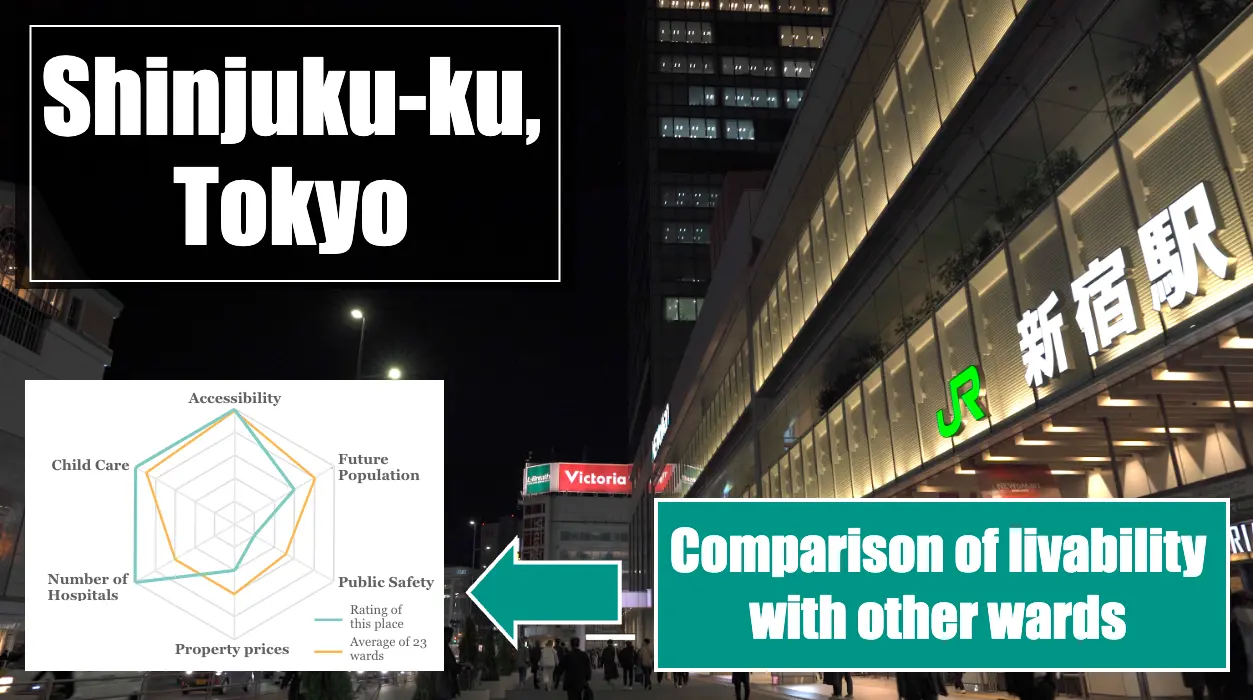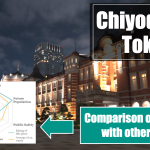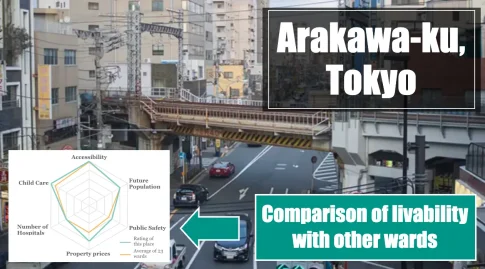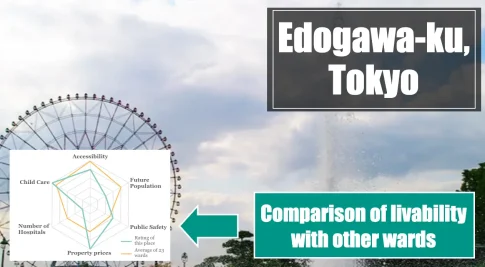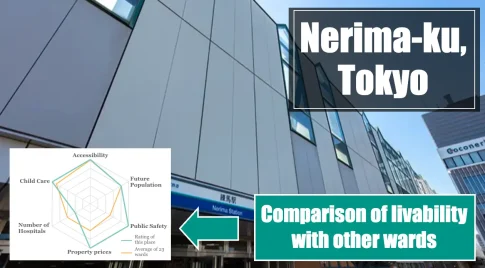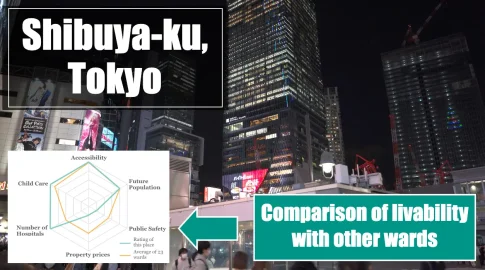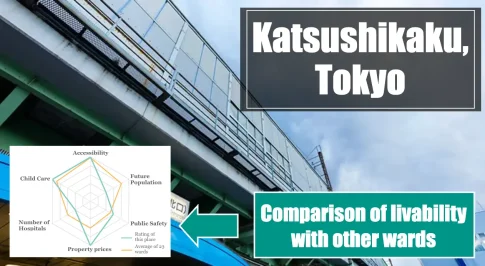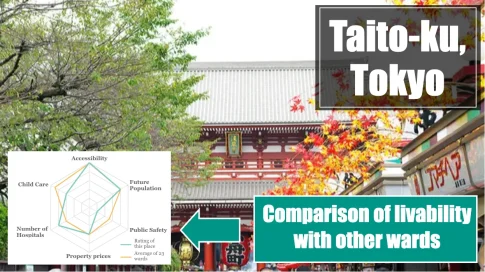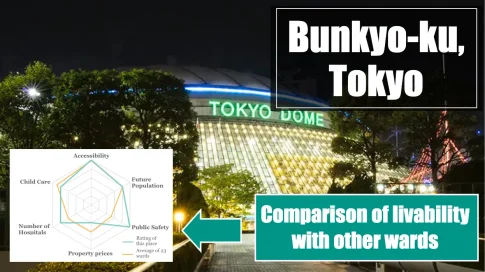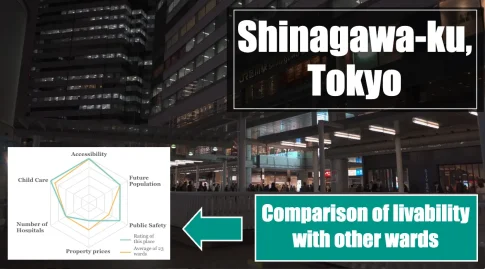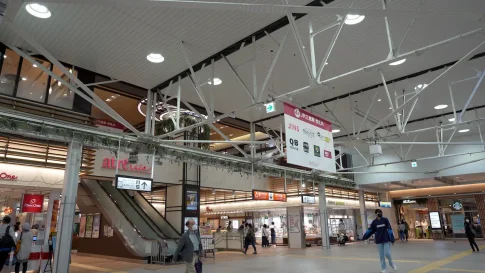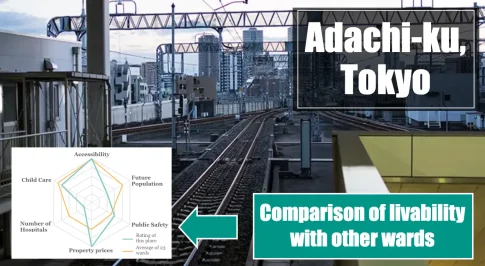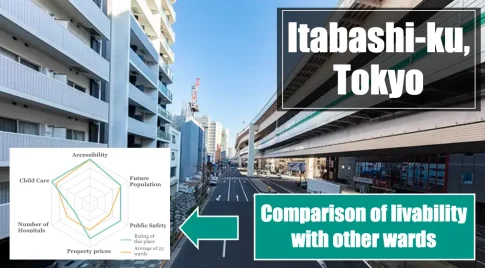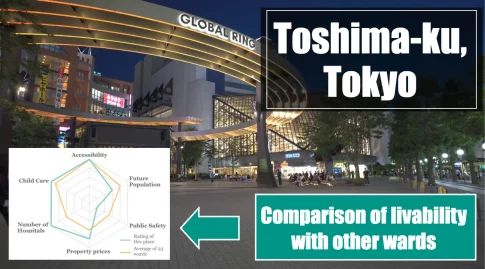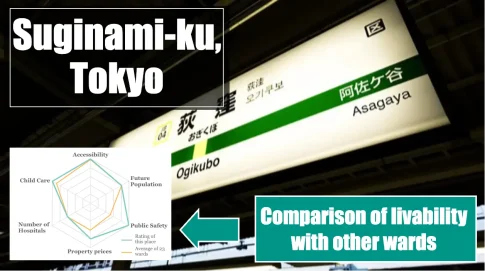This section introduces the livability of Shinjuku-ku, Tokyo, compared to other areas.
Contents
Livability of Shinjuku City|First Conclusion
- Number of hospitals
- No. of children on waiting list 0
- Not safe in Tokyo
- High property prices
Shinjuku City is the center of Tokyo’s 23 wards, as it is home to the Tokyo Metropolitan Government Building and Kabukicho, one of the world’s most popular entertainment districts. With numerous offices and universities, Shinjuku City is also a city that welcomes people of all ages.
However, the area is not very safe and the property prices are high.
The following is a detailed introduction with specific figures, so if you are considering moving to Shinjuku City, please take a look at it until the end.
Compare Shinjuku City with other wards
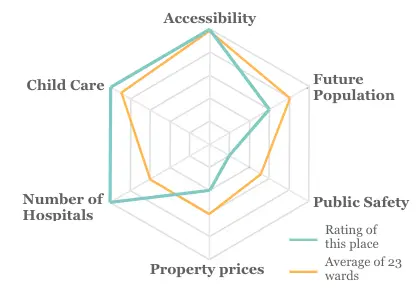
▼Accessibility
Calculated by the time it takes to get out to the Yamanote Line station.
5 = within 15 minutes
4 = within 20 minutes
3 = within 25 minutes
2 = within 30 minutes
1=more than 30 minutes
▼ Future Population
Calculated as percent change in population in 2045 relative to current population.
Over 110% = 5
Over 100% = 4
Over 90% = 3
Over 80% = 2
Less than 80% = 1
▼ Public Safety
The number of perceived crimes per 1,000 population is evaluated using the following criteria
5= less than 4 crimes per 1,000 people
4= less than 5
3= less than 6
2= less than 8
1= more than 8
▼ Property prices
Compared to the respective averages for rentals and condominiums in the 23 wards of Tokyo
5=30% or more reasonable price
4=10% or more but less than 30% of the price of the property
3=Less than 10% of the price before or after
2 = 10% or more but less than 30% more expensive price
1 = 30% or more expensive price
and then summed and re-evaluated.
▼ Number of medical facilities
(The number of medical facilities is evaluated against the average of Tokyo’s 23 wards (excluding extremely expensive wards) using the following criteria.
5=30% or more
4=10% or more but less than 30
3=10% or more, but less than 10%.
2=10% or more but less than 30
1=30% or more
▼ Child Care
The following criteria are used to evaluate against the number of children on waiting lists.
5 = 0 children on waiting list
4=Less than 5 children on the waiting list
3=Less than 10 children on the waiting list
2=Less than 50 children on the waiting list
1 = 50 or more children on the waiting list
Above, the green line is the valuation of Shinjuku Ward, and the orange line is the average valuation of the other 23 wards of Tokyo. Let us look at each of them in turn.
Accessibility of Shinjuku City

- JR Yamanote Line: “Shinjuku Station”, “Takadanobaba Station”, “Shin-Okubo Station
- JR Sobu Line: Shinjuku Station, Shinanomachi Station, Okubo Station
- JR Chuo Line: Shinjuku Station, Shinanomachi Station, Okubo Station
- JR Saikyo Line: Shinjuku Station
- JR Chuo Main Line: “Shinjuku” station
- JR Shonan Shinjuku Line (Takasaki – Tokaido Main Line): Shinjuku Station
- JR Shonan Shinjuku Line (Tohoku Main Line – Yokosuka Line): Shinjuku Station
- Keio Line: Shinjuku Station
- Keio New Line: Shinjuku Station
- Odakyu Odawara Line: Shinjuku Station
- Seibu Shinjuku Line: Seibu Shinjuku Station, Takadanobaba Station, Shimo-Ochiai Station, Nakai Station
- Tokyo Metro Marunouchi Line (Ikebukuro-Ogikubo): Yotsuya Station, Yotsuya-Sanchome Station, Shinjuku-Gyoenmae Station, Shinjuku-Sanchome Station, Shinjuku Station, Nishi-Shinjuku Station
- Tokyo Metro Tozai Line: Ochiai Station, Takadanobaba Station, Waseda Station, Kagurazaka Station
- Tokyo Metro Namboku Line: “Yotsuya” station
- Tokyo Metro Fukutoshin Line: Nishiwaseda Station, Higashi-Shinjuku Station, Shinjuku-Sanchome Station
- Toei Shinjuku Line: Shinjuku Station, Shinjuku Sanchome Station, Akebonobashi Station
- Toei Oedo Line: Tochomae Station, Shinjuku-Nishiguchi Station, Higashi-Shinjuku Station, Wakamatsukawada Station, Ushigome-Yanagicho Station, Ushigome-Kagurazaka Station
- Toei Arakawa Line: “Mengebashi Station” “Waseda Station
Shinjuku City has 18 lines and 30 stations.
Shinjuku Station is known as the busiest station in the world because it is served by the Chuo Line, Keio Line, and Odakyu Line, three major arteries connecting western Tokyo with central Tokyo, as well as the Saikyo Line and Shonan Shinjuku Line running north-south.
In addition, Shinjuku Station is home to Basta Shinjuku, a bus terminal that serves as a hub for buses heading to destinations throughout Japan.

Even though the bullet train does not go through, Shinjuku’s accessibility can be said to be one of the best in Japan from the above points.
Shinjuku City Population and Future Population
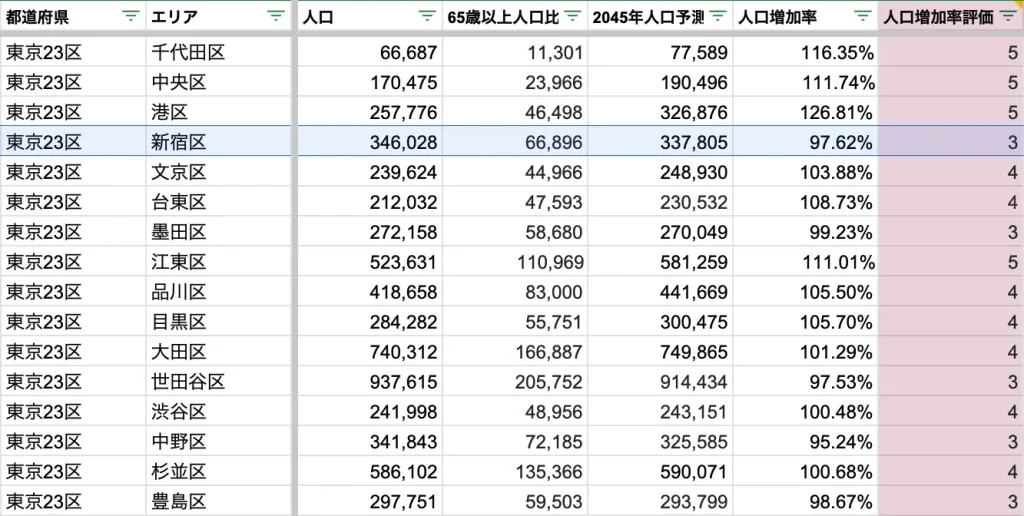
The population of Shinjuku City is approximately 346,000.
The future population in 2045 will be 337,000 (97.62%), about 8,000 fewer than today.

In Tokyo, where the population is on the rise, the decline in Shinjuku City may seem a bit surprising. However, Shinjuku City is a large area, with many student districts and traditional residential areas scattered throughout the city.
For this reason, the area is relatively susceptible to the effects of population decline.
Is Shinjuku city safe?

Compared to the surrounding wards, Shinjuku City gives the impression of being a “bad” place to live.
The number of crimes in 2022 was 4,820, which is 13.93 crimes per 1,000 people in Shinjuku City.
Since the average number of crimes per 1,000 people in other wards is about 6 to 7 (excluding some areas with high figures), the security situation in Shinjuku City was rated as “poor.

The presence of Kabukicho, one of the world’s leading entertainment districts, is probably another factor that makes Shinjuku City look unsafe. It is important to recognize that the safety of Shinjuku City as a whole is not equally bad.
Property quotes in Shinjuku Ward
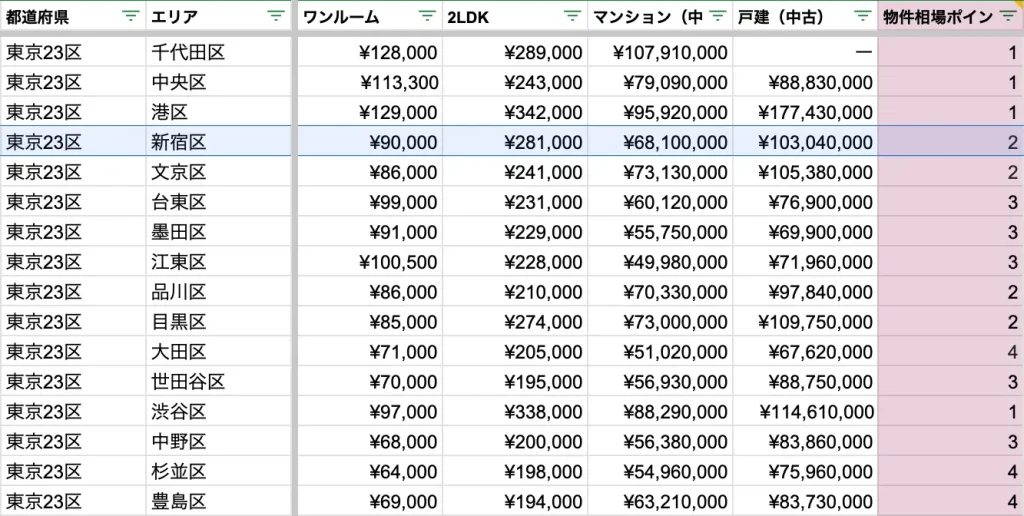
- One room rental = approx. 90,000 yen
- 2LDK rental = approx. 281,000 yen
- Condominium for sale = approx. 68,000,000 yen
- Detached house = approx. 103 million yen
The property market prices for rentals and sales in Shinjuku Ward are shown above. As shown in the table, compared to other surrounding wards, the property market prices in Shinjuku City seem to be high.
However, it does not mean that there are no inexpensive properties. At the time of the article’s production, the lowest price in Shinjuku City was 32,000 yen per month for a 64-year-old, 11-square-meter studio rental.
Incidentally, if you are willing to go a little further away from Shinjuku, the average market price for a studio room is 68,000 yen in the neighboring Nakano Ward, and 200,000 yen for a 2LDK room. Along the Chuo Line, a studio in Suginami Ward is 64,000 yen and a 2LDK is 200,000 yen. In Mitaka City, a studio is 60,000 yen and 2LDK is 135,000 yen.
If you move to Tachikawa City, the price drops to 53,000 yen for a studio and 108,000 yen for a 2LDK.
The trend is the same along the Keio Line and Odakyu Line, and the further away from Shinjuku, the lower the rent tends to be.

If you want to enjoy Tokyo life at a bargain price, you may want to move a little outside the city.
Number of Hospitals in Shinjuku City
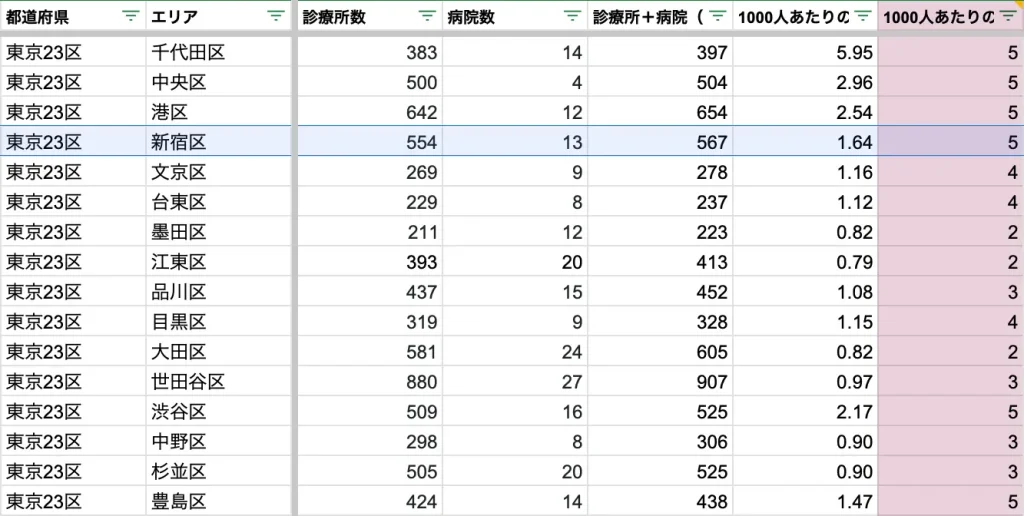
There are 567 hospitals and other medical facilities in Shinjuku City. Calculated on a per 1,000 person basis, the number of hospitals and other medical facilities in Shinjuku City is 1.64, which can be said to be a “high” level compared to other wards.

The fact that there are many clinics is a good point, but it is also important to note that there are several large hospitals there that can perform difficult surgeries.
Shinjuku City Childcare

As for childcare, the data for 2022 shows that there were 64 licensed childcare facilities and zero children on the waiting list.

There are some wards in Tokyo that have waiting lists for children. In contrast, Shinjuku City has zero children, which is a great point for families who want to leave their children in the care of their children.
“待機児童=Taiki jidō” in Japan refers to children who need but can’t secure a spot in childcare facilities due to shortage. This is a major social issue.
What you need to know before moving to Shinjuku City

Here we report on the contents of the regional hazard measurement survey for earthquakes published by the Tokyo Metropolitan Government Bureau of Development.
The above figure shows a color-coded five-level “overall danger level” calculated from the “building collapse danger level” and “fire danger level.
According to the chart, Shinjuku City has the lowest risk level, Rank 1 (light blue areas), to the highest risk level, Rank 5 (brown areas).
The areas with particularly high risk (ranks 4-5) are as follows
- Wakaba 3-chome, Shinjuku-ku, Tokyo
- Akagishita-machi, Shinjuku-ku, Tokyo
- 3 Kagurazaka, Shinjuku-ku, Tokyo
- 4 Kagurazaka, Shinjuku-ku, Tokyo
- 6 Kagurazaka, Shinjuku-ku, Tokyo
etc.

For more information, please visit the Shinjuku-ku page of the Tokyo Metropolitan Government Bureau of Development. If you are considering moving to Shinjuku, we recommend that you take a look at this page.
Shinjuku City livability summary
- Although there is no bullet train, accessibility is excellent 【Good!】
- Population is expected to decrease in the future.
- Security is poor 【Bad!】
- Property prices are high 【Bad!】
- There are many hospitals 【Good!】
- No children on waiting lists 【Good!】
We checked the livability of Shinjuku City and found the above.
It is a good point that there are many hospitals and there are no children on waiting lists. On the other hand, it is important to note that the security is poor and the property prices are high.

If you are considering moving to Japan, why not consider Shinjuku as a candidate?
▼Population
https://www.metro.tokyo.lg.jp/tosei/tokyoto/profile/gaiyo/kushichoson.html
▼Future population
https://jmap.jp/cities/detail/city/13104
▼Public order
https://www.keishicho.metro.tokyo.lg.jp/about_mpd/jokyo_tokei/jokyo/ninchikensu.files/R4.csv
▼Market price of property
https://www.chintai.net/tokyo/area/13100/rent/1r/
https://www.homes.co.jp/mansion/chuko/tokyo/chiyoda-city/price/
https://www.homes.co.jp/kodate/chuko/tokyo/23ku/city/price/
▼Taiki jido
https://www.hokatsunomikata.com/taiki_infos/631
▼Number of Hospitals
https://jmap.jp/cities/detail/city/13104
▼Number of approved childcare facilities
https://www.fukushi.metro.tokyo.lg.jp/kiban/fukushi_shisetsu/shs_list/202305.html
▼Tokyo Earthquake Hazard Level
https://www.toshiseibi.metro.tokyo.lg.jp/bosai/chousa_6/home.htm#project
The information published on this site is the data at the time of the survey. Therefore, please be sure to check the latest data by yourself.
